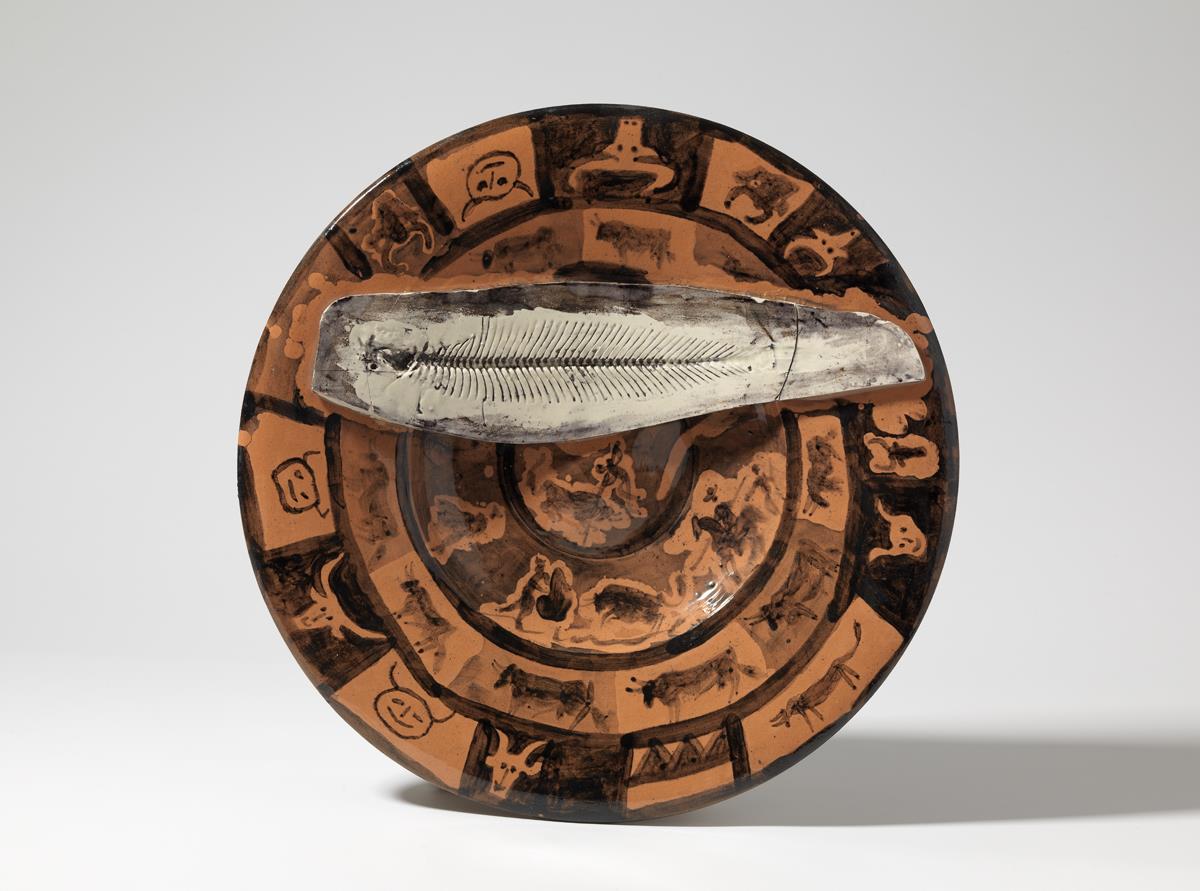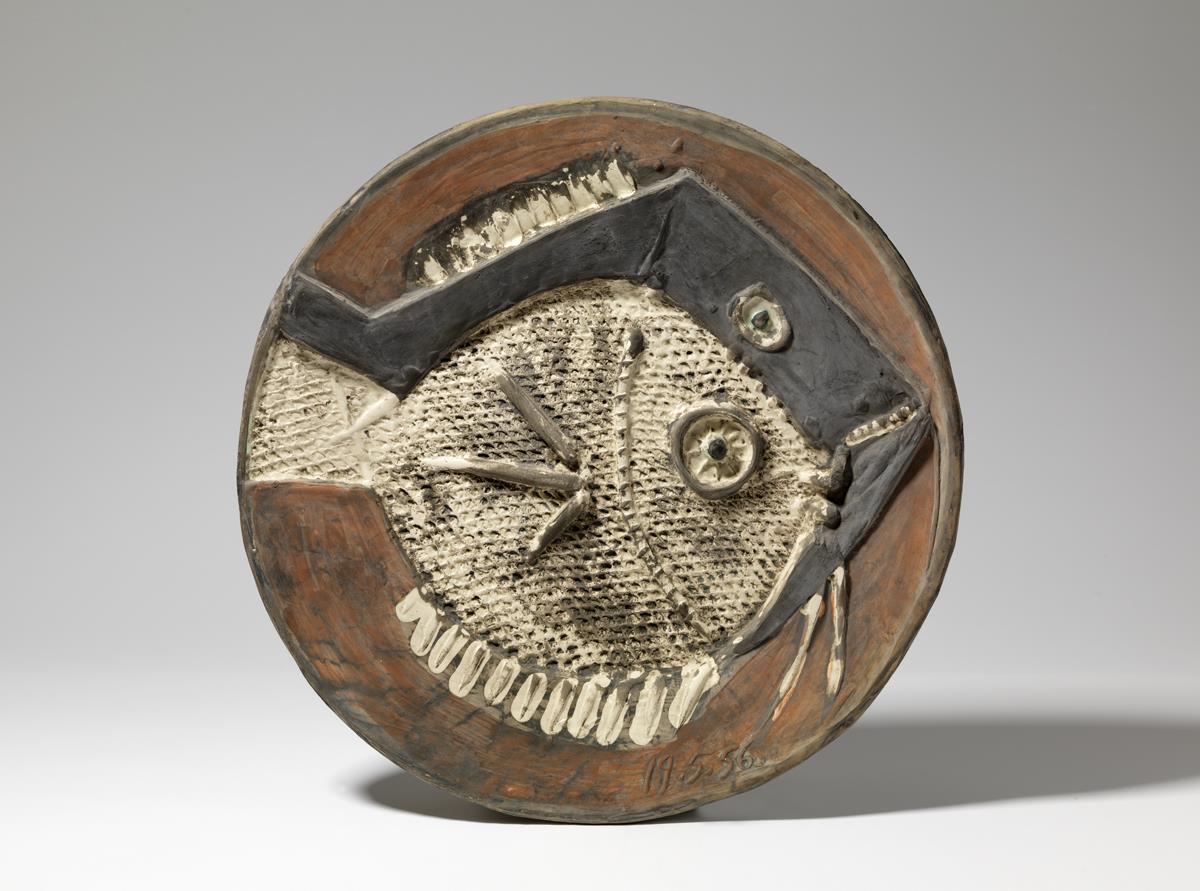Pablo Picasso. Bullfight and Fish (verso: Faces). Cannes, 16/04/1957. Thrown red earthenware with applied fish (white earthenware impressed with fish skeleton, transparent glaze, grey patina; cracked and repaired), decorated with patina and black oxide, partial brushed transparent glaze. Verso: brushed transparent glaze, incised decoration, and black patina. 42 cm of diameter. Museu Picasso, Barcelona. MPB112.446. Gift of Jacqueline Picasso, 1982. Photography, Gasull Fotografia © Succession Pablo Picasso, VEGAP, Madrid 2018
Earth, water and fire are the essential ingredients of the kitchen and pottery, activities linked in the origin of humanity. For the first humans, fire represented a point of inflection due to the incorporation in the diet of cooked foods, but also for other uses such as protection against predators or the development of utensils made from ceramics and other materials.
Picasso entered the world of ceramics at a late stage, unlike other artistic disciplines such as printing, painting or sculpture. His initiation began, when, after the war, he would visit the Madoura ceramic workshop in July 1946, in Vallauris, because of an exhibition of potters being held in the town.
The owners of the workshop were Suzanne and Georges Ramié, who offered Picasso the chance of using the materials and installations of the workshop. In return, the workshop would reproduce and commercialize the designs of the artist in limited numbers of copies.
Pablo Picasso. Two fish. Cannes y Vallauris, 19/05/1956. "Empreinte originale": white earthenware, decorated with slips and white glaze, dark patina. Verso: decorated with oxide and grey patina. 42,5 x 22 x 6,3 cm . Museu Picasso, BCN. MPB112.437. Gift of Jacqueline Picasso, 1982 © Succession Pablo Picasso, VEGAP, Madrid 2018
As an anecdote, Mr. Ramié recalls, in one of his writings, the first and short stay of Picasso, where he created three pieces that once they had been modeled, were left there by the author, waiting for a final future baking that never happened.
But destiny goes round and round, and finally, just a year later, the artist returned in August 1947 and found the three abandoned pieces in the workshop that he believed had disappeared. This was the beginning of Picasso the potter. In that same year, with a modeled bull, he started a fruitful task in the form of plates, vases, glasses, figures, mosaics, etc.
In ceramics, as in the kitchen, the ingredients, condiments and cooking are the basis and what defines quality. This relationship seemed to be taken even further by the artist in his works with elements of gastronomy such as sardines, sole, fried eggs, sausages, etc., modeled by him. Bullfighting motifs, scenes of family life, nudes, as well as images clearly inspired by ancient Greek and Roman ceramics, are not lacking.
Pablo Picasso. Trompe-l'oeil ceramic (Sausage and eggs). Vallauris (Madoura Workshop), March 28, 1951. White terracota, moulded, painted with slip and glazed. 31 x 37 x 5,5 cm. Musée d’art moderne, Céret. MAMC 1991-0324. © Succession Pablo Picasso, VEGAP, Madrid 2018
For the artist, Vallauris represented a resurgence of his activity as a sculptor, closely linked to the practice of ceramics, which he embraced intensively between 1947 and 1953, even though he didn’t give up ceramics until 1971, when the artist was close to death.
In 1948 he settled in La Galloise, a house near Madoura, where he has just developed his full potential to assimilate all the concepts that encompass ceramics.
In fact, the artist took this new artistic activity very seriously and assimilated the complex techniques that govern this artistic discipline. He explored the ceramic materials (engobe, oxide and enamel) and learned the peculiarities of colour. He also found the mysteries of baking to be fascinating.
As a reflection of this artistic activity, the film Pablo Picasso à Vallauris, filmed in 1953 by Luciano Emmer, presented the artist in action and his workshop, full of collected objects to meet the sculptural needs of his art such as pieces of scrap and wicker baskets , as well as ceramic dishes and clay fragments.
Another artist who can give us a trustworthy testimony of Picasso the potter is David Douglas Duncan, who recently died, and his series of photographs taken in the house of La Californie in Cannes.
Picasso in La Californie making a dish with Bull. Cannes, 1957. Modern digital copy by inkjet. 50 x 60 cm. David Douglas Duncan’s Archive. David Douglas Duncan. FDDD/5/48. Museu Picasso, Barcelona Archive © Succession Pablo Picasso, VEGAP, Madrid 2018
In Room 07 of the temporary exhibition “Picasso’s kitchen” you will be able to find some ceramic works, such as Cerámica en trompe-la œil (sausage and eggs) (1951), Still life with fish and sliced lemon (1957) or Bullfight and fish (1957).
Written by the Museum








